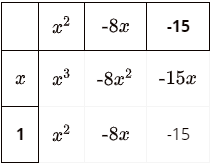Illustrative Math - Algebra 2 - Unit 2 - Lesson 12
By Formative Library
starstarstarstarstar
Last updated about 1 year ago
9 Questions

1
1.
1
2.
1
3.
Tyler thinks he knows one of the linear factors of P(x)=x^{3}-9x^{2}+23x-15. After finding that P(1)=0, he suspects that x-1 is a factor of P(x). Here is the diagram he made to check if he’s right, but he set it up incorrectly. What went wrong?

A.APR.2
A.APR.3
A.SSE.3.a
1
4.
The polynomial function q(x)=2x^{4}-9x^{3}-12x^{2}+29x+30 has known factors (x-2) and (x+1). Which expression represents q(x) as the product of linear factors?
A.APR.2
A.APR.3
A.SSE.3.a

1
5.
1
6.
1
7.
State the degree and end behavior of f(x)=5+7x-9x^{2}+4x^{3}. Explain or show your reasoning.
A.APR.2
A.APR.3
A.SSE.3.a
1
8.
Describe the end behavior of f(x)=1+7x+9x^{3}+6x^{4}-2x^{5}.
A.APR.2
A.APR.3
A.SSE.3.a
1
9.
What are the points of intersection between the graphs of the functions f(x)=(x+3)(x-1) and g(x)=(x+1)(x-3)?
A.APR.2
A.APR.3
A.SSE.3.a
This lesson is from Illustrative Mathematics. Algebra 2, Unit 2, Lesson 12. Internet. Available from https://curriculum.illustrativemathematics.org/HS/teachers/3/2/12/index.html ; accessed 27/July/2021.
IM Algebra 1, Geometry, Algebra 2 is © 2019 Illustrative Mathematics. Licensed under the Creative Commons Attribution 4.0 International License (CC BY 4.0).
The Illustrative Mathematics name and logo are not subject to the Creative Commons license and may not be used without the prior and express written consent of Illustrative Mathematics.
These materials include public domain images or openly licensed images that are copyrighted by their respective owners. Openly licensed images remain under the terms of their respective licenses. See the image attribution section for more information.